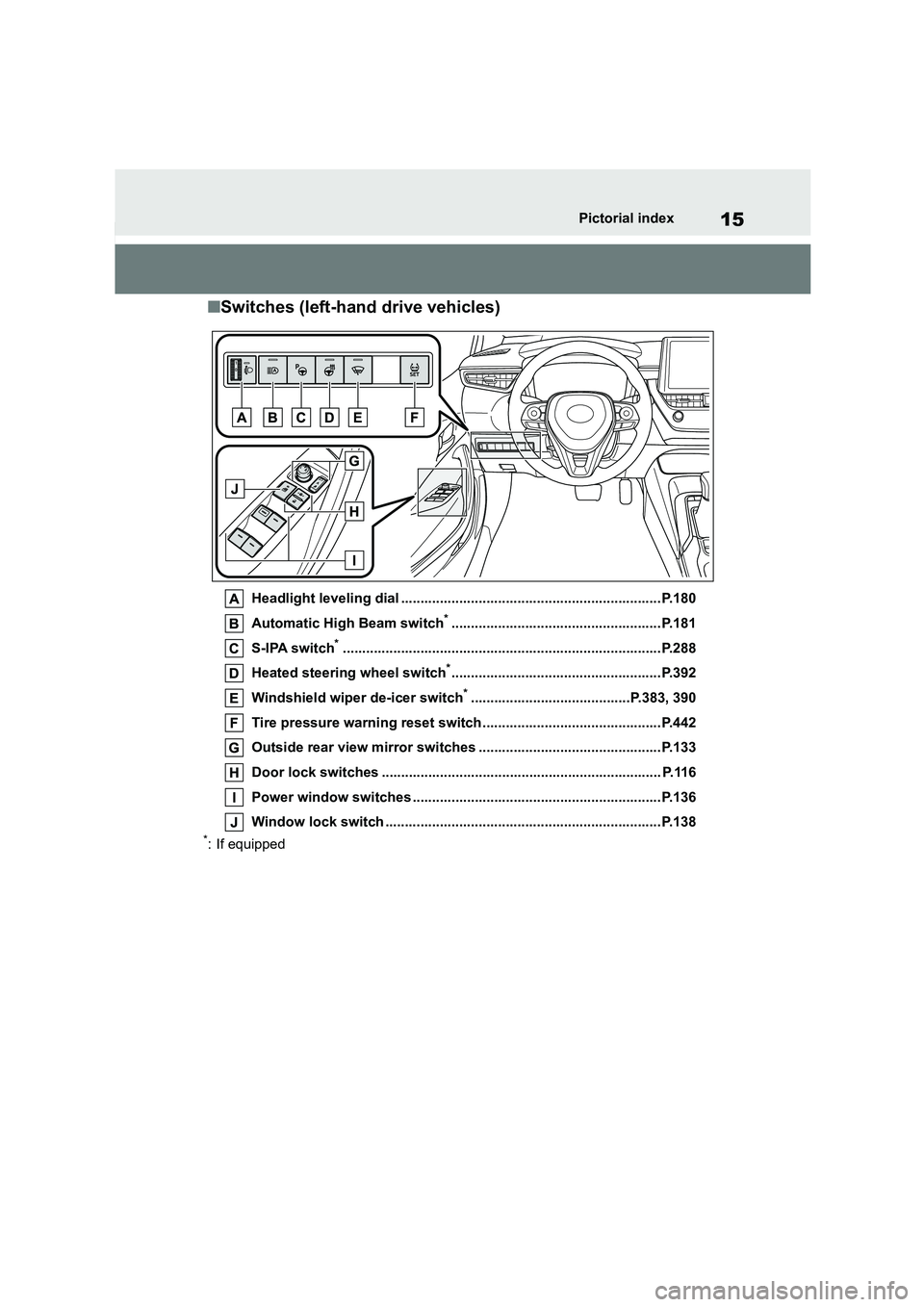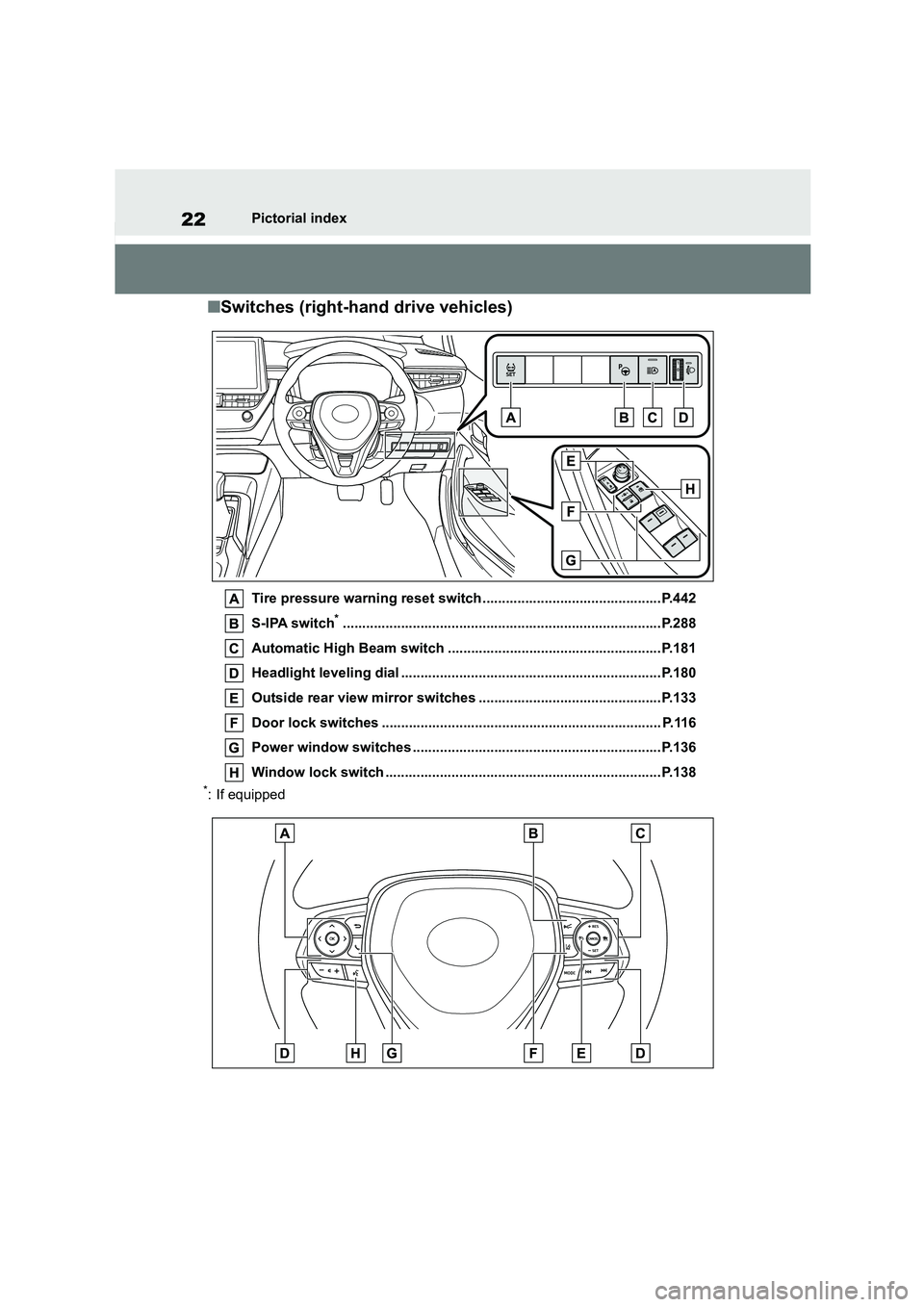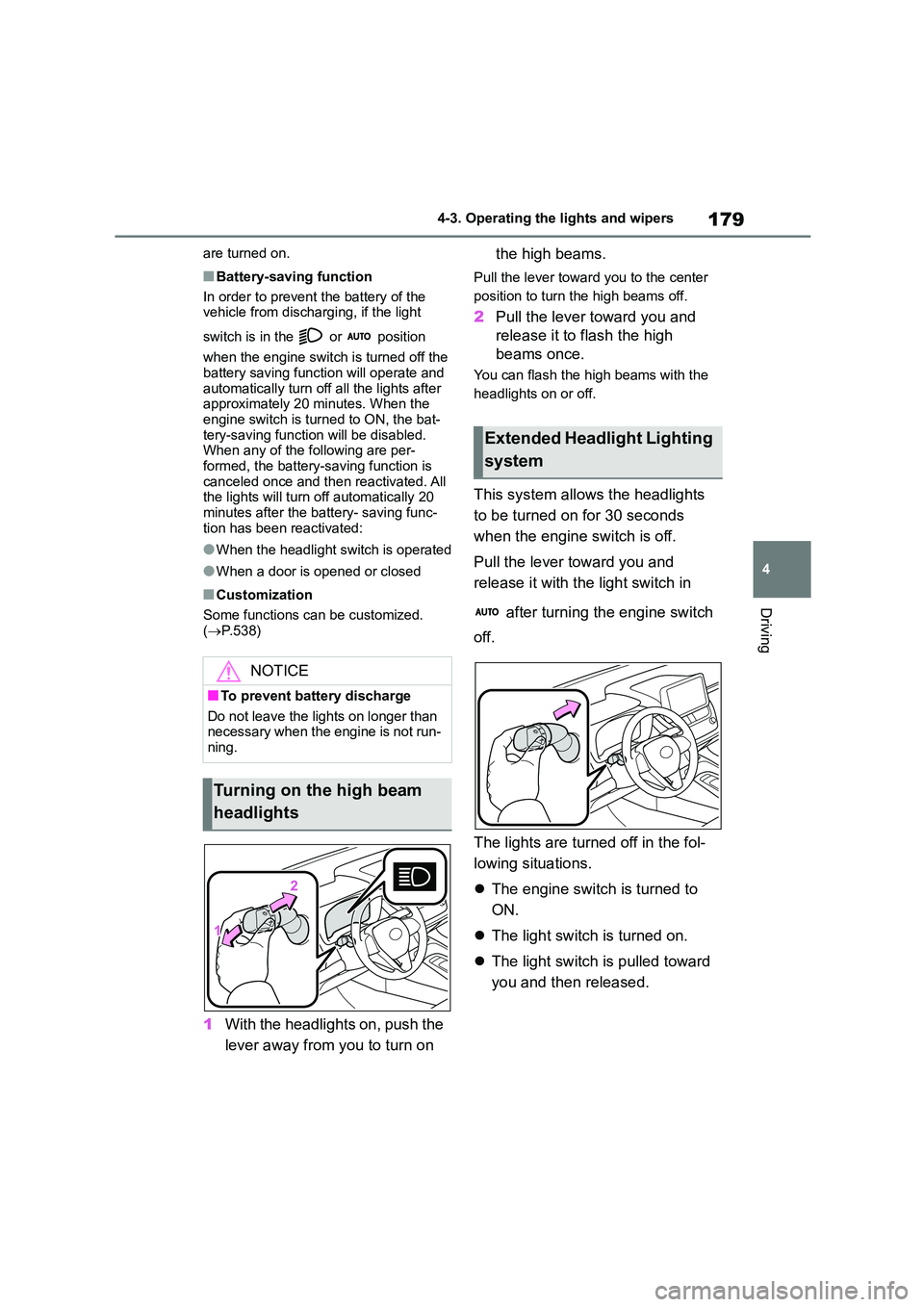2022 TOYOTA COROLLA high beam
[x] Cancel search: high beamPage 5 of 678

3TABLE OF CONTENTS
1
6
5
4
3
2
9
8
7
4-2. Driving procedures
Engine (ignition) switch (vehicles
without a smart entry & start
system) ............................. 159
Engine (ignition) switch (vehicles
with a smart entry & start sys-
tem) .................................. 160
Multidrive ............................ 165
Manual transmission ........... 169
Turn signal lever ................. 171
Parking brake...................... 172
Electric parking brake ......... 173
Brake Hold .......................... 176
4-3. Operating the lights and wip-
ers
Headlight switch.................. 178
AHB (Automatic High Beam)
.......................................... 181
Fog light switch ................... 183
Windshield wipers and washer
.......................................... 184
4-4. Refueling
Opening the fuel tank cap ... 188
4-5. Using the driving support sys-
tems
Toyota Safety Sense ........... 190
PCS (Pre-Collision System)
.......................................... 202
LTA (Lane Tracing Assist) ... 209
LDA (Lane Departure Alert with
steering control) ................ 219
Dynamic radar cruise control
with full-speed range ........ 227
Dynamic radar cruise control
.......................................... 238
Cruise control...................... 249
Speed limiter ....................... 252
RSA (Road Sign Assist) ...... 254
BSM (Blind Spot Monitor) ... 258
Toyota parking assist-sensor
.......................................... 263
RCTA (Rear Crossing Traffic
Alert) function ................... 271
PKSB (Parking Support Brake)
.......................................... 276
Parking Support Brake function
(static objects) .................. 283
Parking Support Brake function
(rear-crossing vehicles) .... 286
S-IPA (Simple Intelligent Parking
Assist System) .................. 288
Driving mode select switch
.......................................... 314
GPF (Gasoline Particulate Filter)
system .............................. 315
Driving assist systems ........ 316
4-6. Driving tips
Winter driving tips ............... 321
5-1. Basic Operations
Audio system types............. 326
Using the steering wheel audio
switches ............................ 327
USB port ............................. 328
5-2. Using the audio system
Optimal use of the audio system
.......................................... 329
5-3. Using the radio
Radio operation .................. 331
5-4. Playing an audio CD and
MP3/WMA discs
CD player operation ............ 333
5-5. Using an external device
Listening to an iPod ............ 339
5Audio system
Page 17 of 678

15Pictorial index
■Switches (left-hand drive vehicles)
Headlight leveling dial ...................................................................P.180
Automatic High Beam switch*......................................................P.181
S-IPA switch*..................................................................................P.288
Heated steering wheel switch*......................................................P.392
Windshield wiper de-icer switch*.........................................P.383, 390
Tire pressure warning reset switch ..............................................P.442
Outside rear view mirror switches ...............................................P.133
Door lock switches ........................................................................ P.116
Power window switches ................................................................P.136
Window lock switch .......................................................................P.138
*: If equipped
Page 24 of 678

22Pictorial index
■Switches (right-hand drive vehicles)
Tire pressure warning reset switch ..............................................P.442
S-IPA switch*..................................................................................P.288
Automatic High Beam switch .......................................................P.181
Headlight leveling dial ...................................................................P.180
Outside rear view mirror switches ...............................................P.133
Door lock switches ........................................................................ P.116
Power window switches ................................................................P.136
Window lock switch .......................................................................P.138
*: If equipped
Page 85 of 678

83
2
2-1. Instrument cluster
Vehicle status information and indicators
The indicators inform the driver of
the operating state of the vehicle’s
various systems.
WA R N I N G
■If a safety system warning light
does not come on
Should a safety system light such as the ABS and SRS warning light not
come on when you start the engine,
this could mean that these systems are not available to help protect you in
an accident, which could result in
death or serious injury. Have the vehi-
cle inspected by any authorized Toyota retailer or Toyota authorized
repairer, or any reliable repairer
immediately if this occurs.
Indicators
Turn signal indicator
( P.171)
Tail light indicator ( P.178)
Headlight high beam indica-
tor ( P.179)
Automatic High Beam indica-
tor (if equipped) ( P.181)
Front fog light indicator (if
equipped) ( P.183)
Rear fog light indicator
( P.183)
PCS warning light*1, 2 (if
equipped) ( P.204)
Cruise control indicator (if
equipped) ( P.227, 238,
249)
Dynamic radar cruise control
indicator (if equipped)
( P.227, 238)
Cruise control “SET” indica-
tor (if equipped) ( P.227,
238, 249)
*3
LTA indicator (if equipped)
( P.214)
LDA indicator (if equipped)
( P.223)
BSM outside rear view mirror
indicators*1, 4 (if equipped)
( P.259)
BSM indicator (if equipped)
( P.259)
Toyota parking assist-sensor
OFF indicator*1, 2 (if
equipped) ( P.264)
RCTA OFF indicator*1, 2 (if
equipped) ( P.272)
PKSB OFF indicator*1, 2 (if
equipped) ( P.277)
Speed limiter indicator (if
equipped) ( P.252)
S-IPA indicator*1 (if
equipped) ( P.288)
(Flashes)
Slip indicator*1 ( P.317)
VSC OFF indicator*1, 2
( P.317)
Smart entry & start system
indicator*5 (if equipped)
( P.160)
Gear Shift Indicator (if
equipped) ( P.170)
Parking brake indicator
( P.172, 173)
Brake hold standby indica-
tor*1 (if equipped) ( P.176)
Brake hold operated indica-
tor*1 (if equipped) ( P.176)
Page 145 of 678

4
143
4
Driving
Driving
.4-1. Before driving
Driving the vehicle ............ 145
Cargo and luggage ........... 152
Trailer towing (for M15A-FKS
engine) ........................... 153
Trailer towing (except for
M15A-FKS engine) ......... 158
4-2. Driving procedures
Engine (ignition) switch (vehi-
cles without a smart entry &
start system) ................... 159
Engine (ignition) switch (vehi-
cles with a smart entry & start
system) ........................... 160
Multidrive .......................... 165
Manual transmission ......... 169
Turn signal lever ............... 171
Parking brake ................... 172
Electric parking brake ....... 173
Brake Hold ........................ 176
4-3. Operating the lights and wip-
ers
Headlight switch ............... 178
AHB (Automatic High Beam)
....................................... 181
Fog light switch ................. 183
Windshield wipers and washer
....................................... 184
4-4. Refueling
Opening the fuel tank cap
....................................... 188
4-5. Using the driving support
systems
Toyota Safety Sense ......... 190
PCS (Pre-Collision System)
........................................ 202
LTA (Lane Tracing Assist)
........................................ 209
LDA (Lane Departure Alert with
steering control) .............. 219
Dynamic radar cruise control
with full-speed range ...... 227
Dynamic radar cruise control
........................................ 238
Cruise control.................... 249
Speed limiter ..................... 252
RSA (Road Sign Assist) .... 254
BSM (Blind Spot Monitor)
........................................ 258
Toyota parking assist-sensor
........................................ 263
RCTA (Rear Crossing Traffic
Alert) function ................. 271
PKSB (Parking Support Brake)
........................................ 276
Parking Support Brake function
(static objects) ................ 283
Parking Support Brake function
(rear-crossing vehicles) .. 286
S-IPA (Simple Intelligent Park-
ing Assist System) .......... 288
Driving mode select switch
........................................ 314
GPF (Gasoline Particulate Fil-
ter) system ...................... 315
Page 181 of 678

179
4
4-3. Operating the lights and wipers
Driving
are turned on.
■Battery-saving function
In order to prevent the battery of the vehicle from discharging, if the light
switch is in the or position
when the engine switch is turned off the battery saving function will operate and
automatically turn off all the lights after
approximately 20 minutes. When the engine switch is turned to ON, the bat-
tery-saving function will be disabled.
When any of the following are per- formed, the battery-saving function is
canceled once and then reactivated. All
the lights will turn off automatically 20 minutes after the battery- saving func-
tion has been reactivated:
●When the headlight switch is operated
●When a door is opened or closed
■Customization
Some functions can be customized.
( P.538)
1With the headlights on, push the
lever away from you to turn on
the high beams.
Pull the lever toward you to the center
position to turn the high beams off.
2 Pull the lever toward you and
release it to flash the high
beams once.
You can flash the high beams with the
headlights on or off.
This system allows the headlights
to be turned on for 30 seconds
when the engine switch is off.
Pull the lever toward you and
release it with the light switch in
after turning the engine switch
off.
The lights are turned off in the fol-
lowing situations.
The engine switch is turned to
ON.
The light switch is turned on.
The light switch is pulled toward
you and then released.
NOTICE
■To prevent battery discharge
Do not leave the lights on longer than necessary when the engine is not run-
ning.
Turning on the high beam
headlights
Extended Headlight Lighting
system
Page 183 of 678

181
4
4-3. Operating the lights and wipers
Driving
*: If equipped
1 Press the Automatic High Beam
switch.
2 Push the lever away from you
with the headlight switch in the
or position.
The Automatic High Beam indicator will
come on when the system is operating.
■Conditions to turn the high beams
on/off automatically
●When all of the following conditions
are met, the high beams will be turned on automatically (after approximately
1 second):
• The vehicle speed is approximately 40 km/h (25 mph) or more.
• The area ahead of the vehicle is dark.
• There are no vehicles ahead with headlights or tail lights turned on.
• There are few streetlights on the road
ahead.
●If any of the following conditions are
met, the high beams will turn off auto- matically:
• The vehicle speed is below approxi-
mately 30 km/h (19 mph). • The area ahead of the vehicle is not
dark.
• Vehicles ahead have their headlights or tail lights turned on.
• There are many streetlights on the
road ahead.
■Camera sensor detection informa-
tion
●The high beams may not be automati-
cally turned off in the following situa- tions:
• When a vehicle suddenly appears
from around a curve
AHB (Automatic High
Beam)*
The Automatic High Beam
uses a camera sensor located
behind the upper portion of the
windshield to assess the
brightness of the lights of vehi-
cles ahead, streetlights, etc.,
and automatically turns the
high beams on or off as neces-
sary.
WA R N I N G
■Limitations of the Automatic High Beam
Do not overly rely on the Automatic
High Beam. Always drive safely, tak- ing care to observe your surroundings
and turning the high beams on or off
manually if necessary.
■To prevent incorrect operation of
the Automatic High Beam system
Do not overload the vehicle.
Activating the Automatic
High Beam
Page 184 of 678

1824-3. Operating the lights and wipers
• When the vehicle is cut in front of by
another vehicle • When vehicles ahead cannot be
detected due to repeated curves, road
dividers or roadside trees • When vehicles ahead appear in a far-
away lane on a wide road
• When the lights of vehicles ahead are not on
●The high beams may be turned off if a vehicle ahead that is using fog lights
without its headlights turned on is
detected.
●House lights, streetlights, traffic sig-
nals, and illuminated billboards or signs and other reflective objects may
cause the high beams to change to
the low beams, or the low beams to remain on.
●The following factors may affect the amount of time taken for the high
beams to turn on or off:
• The brightness of the headlights, fog lights, and tail lights of vehicles ahead
• The movement and direction of vehi-
cles ahead • When a vehicle ahead only has oper-
ational lights on one side
• When a vehicle ahead is a two-wheeled vehicle
• The condition of the road (gradient,
curve, condition of the road surface, etc.)
• The number of passengers and
amount of luggage in the vehicle
●The high beams may turn on or off
unexpectedly.
●Bicycles or similar vehicles may not
be detected.
●In the following sit uations the system
may not be able to correctly detect the
surrounding brightness level. This may cause the low beams to remain
on or the high beams to flash or daz-
zle pedestrians or vehicles ahead. In such a case, it is necessary to manu-
ally switch between the high and low
beams. • When driving in inclement weather
(heavy rain, snow, fog, sandstorms,
etc.)
• When the windshield is obscured by fog, mist, ice, dirt, etc.
• When the windshield is cracked or
damaged • When the camera sensor is deformed
or dirty
• When the temperature of the camera sensor is extremely high
• When the surrounding brightness
level is equal to that of headlights, tail lights or fog lights
• When headlights or tail lights of vehi-
cles ahead are turned off, dirty, chang- ing color, or not aimed properly
• When the vehicle is hit by water,
snow, dust, etc. from a preceding vehicle
• When driving through an area of inter-
mittently changing brightness and darkness
• When frequently and repeatedly driv-
ing ascending/descending roads, or roads with rough, bumpy or uneven
surfaces (such as stone-paved roads,
gravel roads, etc.) • When frequently and repeatedly tak-
ing curves or driving on a winding
road • When there is a highly reflective
object ahead of the vehicle, such as a
sign or mirror • When the back of a preceding vehicle
is highly reflective, such as a con-
tainer on a truck • When the vehicle’s headlights are
damaged or dirty, or are not aimed
properly • When the vehicle is listing or titling
due to a flat tire, a trailer being towed,
etc. • When the headlights are changed
between the high beams and low
beams repeatedly in an abnormal
manner • When the driver believes that the high
beams may be flashing or dazzling
pedestrians or other drivers